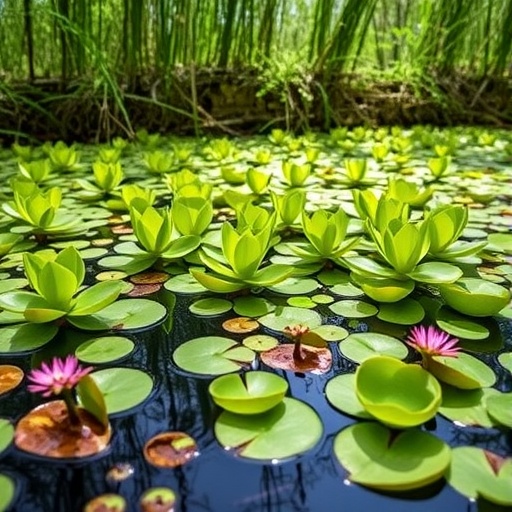In the ongoing battle against climate change, scientists have increasingly turned their attention toward understanding the nuanced roles of various ecosystems in the global greenhouse gas budget. A recent groundbreaking study from Cornell University sheds light on a previously underappreciated factor: the intricate dynamics of aquatic plant communities in shallow freshwater bodies and their effect on greenhouse gas emissions, including methane, carbon dioxide, and nitrous oxide. This research provides vital new insights into how different assemblages of aquatic plants influence not only the concentration but also the flux—the actual emission—of these pivotal gases into the atmosphere.
The study, spearheaded by doctoral researcher Meredith Theus, employed a meticulously designed field experiment at the Cornell Experimental Ponds Facility, spanning from late spring to early fall. Within three separate shallow ponds, Theus established three distinct experimental mesocosms or ‘corrals’ that allowed for careful manipulation of aquatic plant compositions. These treatments isolated submerged plants anchored to pond sediments, floating plants like duckweed that drift atop the water surface, and phytoplankton—microscopic photosynthetic organisms dispersed throughout the water column. By monitoring these different communities independently, the research could pinpoint their relative contributions to greenhouse gas dynamics.
Detailed biweekly measurements involved analyzing water column chemistry, particularly dissolved concentrations of methane (CH4), carbon dioxide (CO2), and nitrous oxide (N2O), along with greenhouse gas fluxes emanating from the pond surfaces into the atmosphere. Flux data were collected via a portable gas analyzer capable of detecting subtle variations in gas emissions over time. The uncommon integration of concentration data with concurrent flux measurements proved essential for unraveling the complex relationships between biological processes within aquatic habitats and their climatic implications.
Perhaps most strikingly, the combined presence of submerged and floating plants yielded the highest dissolved concentrations of carbon dioxide and methane within the pond water, whereas nitrous oxide levels were comparatively diminished. Yet, contrary to intuitive expectations, these elevated in-water concentrations did not translate into significantly higher emissions to the atmosphere. Methane and carbon dioxide fluxes measured above each treatment were statistically similar across all plant communities tested, indicating a decoupling between gas concentration in water and release rates.
This paradox reveals an intricate ecological mechanism limiting the diffusion of potent greenhouse gases into the atmosphere despite their abundance below the surface. Co-author Meredith Holgerson, an associate professor specializing in Ecology and Evolutionary Biology, suggests that the floating plants—especially duckweed—act as a physical barrier or ‘lid’ over the water surface. This dense vegetative mat impedes the escape of gas molecules, effectively trapping methane and carbon dioxide underneath and potentially altering microenvironmental chemistry.
Adding another layer of complexity, the study highlights the presence of methanotrophic bacteria residing in the roots of duckweed. These specialized microorganisms consume methane as a metabolic substrate, oxidizing it before it can enter the atmosphere. This microbial methane oxidation within the plant root zone contributes to the observed disconnect between methane concentration and flux, underscoring the critical roles of both plant morphology and microbial communities in regulating greenhouse gas emissions.
The temporal resolution of gas flux measurements, conducted every two weeks, introduces certain limitations in fully capturing episodic emission events. For instance, strong winds or disturbances that consolidate floating plants to the side of a pond might transiently enhance gas release, an effect not fully reflected in the biweekly sampling schema. Hence, future research employing continuous monitoring techniques will be vital to capture these dynamic fluctuations and provide a comprehensive emission profile.
From a broader perspective, these findings significantly advance our understanding of how aquatic ecosystems influence greenhouse gas cycling. Methane, in particular, accounts for about half of global emissions originating from aquatic systems such as wetlands, ponds, and shallow lakes. Given methane’s potency—approximately 28 times greater than carbon dioxide over a century—determining the ecological factors that govern its production and emission is critical for climate mitigation efforts.
The implications for ecosystem management are profound. Strategically managing the composition and structure of aquatic plant communities could become a tool for mitigating greenhouse gas emissions from inland waters. For example, fostering floating plant mats might reduce immediate atmospheric methane fluxes, while also supporting communities of methanotrophs that naturally degrade methane. However, the associated increase in dissolved greenhouse gases beneath such mats suggests trade-offs that require careful consideration in any management strategy.
Importantly, the study calls attention to the complexity and heterogeneity of freshwater ecosystems, where biological, chemical, and physical processes intersect to influence greenhouse gas dynamics. The interplay between plant physiology, microbial ecology, and physical gas exchange necessitates multidisciplinary approaches moving forward, combining field experimentation, molecular microbiology, and advanced biogeochemical modeling.
This research from Cornell University serves as an essential step toward disentangling these complexities. By elucidating the nuanced role of aquatic plant communities in greenhouse gas emissions, it provides a foundation for future investigations aimed at developing informed strategies to curb climate change at the interface of terrestrial and aquatic environments.
As climate scientists continue to refine global greenhouse gas budgets, understanding these local-scale processes within freshwater ecosystems will become increasingly vital. Integrating such ecological knowledge into climate policy and environmental management could harness natural biological interactions to mitigate humanity’s warming footprint, offering a hopeful avenue amidst the urgency of global climate challenges.
Subject of Research: The impact of aquatic plant community composition on methane, carbon dioxide, and nitrous oxide production, transport, and emission in shallow freshwater ecosystems.
Article Title: (Not specified in the provided content)
News Publication Date: August 27, 2025
Web References:
– Study article: https://www.sciencedirect.com/science/article/pii/S0304377025000622
– Cornell Chronicle story: https://news.cornell.edu/stories/2025/08/certain-communities-pond-plants-may-increase-greenhouse-gases
References: The study referenced is published in the journal Aquatic Botany.
Image Credits: Not provided.
Keywords: Greenhouse gases, methane, carbon dioxide, nitrous oxide, aquatic plants, duckweed, submerged plants, phytoplankton, freshwater ecosystems, greenhouse gas flux, methane oxidation, aquatic ecology.




